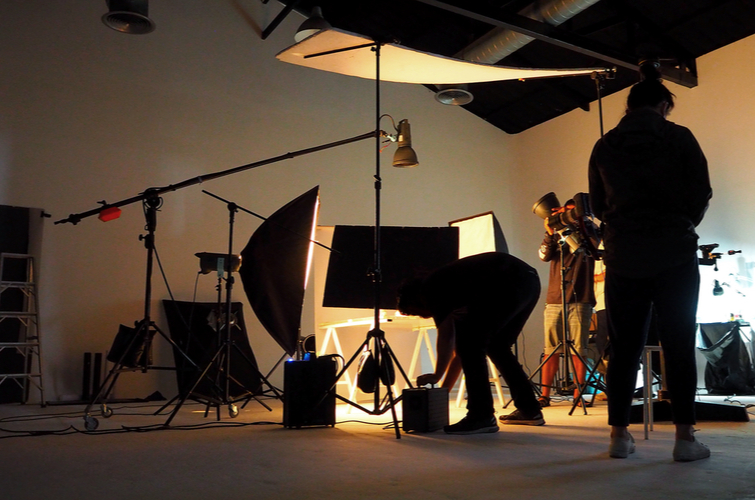
How to Sell Video Solutions to SMBs and Get More Repeat Business
Here’s the tried-and-true best approach for selling video solutions to your small business clients. Follow these steps to keep them coming back.
Looking to sell some simple yet effective video solutions to small businesses? Want to turn these one-off projects into solid repeat business? Here’s a complete guide to understanding a small business’s needs, pitching the value of your services, and a few tips for navigating the sales process from discovery to post-project.
Video Production Service

The first day on set for a new client. Image via sippakorn.
Before we go into how to sell video, let’s define some terms first. A Video Production Service is any entity, person, or company that offers a wide variety of video production options to clients. A video expert would define themselves by the equipment and gear that they use, their unique industry knowledge and skills, as well as their production team and where they operate.
Let’s take the example of a small-to-medium-sized video production company that employs several employees. This company has a few repeat customers and long-running projects, but their continued success and growth depends on finding new clients, pitching services that meet their needs, and convincing them to buy video solutions.
I say “solutions” as opposed to just “video services” because I believe that having this mentality can really benefit video experts as they approach clients who are looking for something to support their marketing, recruiting, and sales goals.
The steps to this sales stage process include everything that happens before a client signs a contract: initial brand awareness, advertising, demos, client interviews, sales pitches, and presentations.
Once this initial sales stage is done, then the actual production stage can begin, from the day-to-day work on the development of the video all the way to the final delivery of the video and assets.
Video Production Service from a Client’s Perspective

Help your client understand what kind of video will benefit them most. Image via gnepphoto.
Depending on the type of business they are and the products and services they offer, “video production services” can mean many different things from a client’s perspective.
Small business owners often view video production much more in terms of advertising or marketing expenses, and at times it can be a struggle for them to understand the exact processes and skills needed for video creation.
Because of this, video professionals should make education a big part of the sales process. A good way to approach this is to familiarize prospective clients with the various stages of the upcoming production process — the discovery stage, the pitch stage, the onboarding stage, the product stage, the edit stage, and the delivery stage.
Discovery Stage

Make sure your potential clients can find you and see some of your work. Image via Tashatuvango.
Essentially, your connection with a potential client is going to start taking shape when said client first “discovers” you and your services. The most common form of this discovery comes from demo videos on your site and work samples on your social media channels.
Ideally these will showcase the very best aspects of your video production offering, as well as give a good glimpse into the different types of video services you offer. Another way to tackle this is with testimonial videos which can give even more insights into how your video services can be helpful to your clients by solving their unique needs.
Pitch Stage

When you pitch your ideas, make sure you’re explaining the benefits in language they can understand. Image via godshutter.
After the discovery stage, it’s time for the pitch. This stage is absolutely crucial.
In this stage, a video provider needs to be able to speak the language of a small business owner or marketing manager in order to best explain how their video services will help.
It’s also a good idea to provide references and examples of past work that line up with the small business’s needs. Be transparent with the costs, and always be ready to justify the value associated with the price of your services.
Onboarding Stage
After the pitch stage, the onboarding stage sets the foundation for trust and future repeat business. The first steps of the onboarding stage include an initial interview to identify the small business’s specific needs. Are they looking for increased sales and profit? Are they trying to find new hires or improve employee retention? Are they looking to elevate their sales presentations? Keep them talking, and don’t be afraid to keep asking questions.
Be patient in this process, and be sure to explain everything in great detail. As a tip, I’d say it’s best to avoid getting too technical in this process — leave your video slang at home. Instead, try to incorporate their language to demonstrate that you properly understand their needs. Finally, give a timeline and list out all the deliverables that will be included in the project once it’s complete.
Product Stage
From there, it’s important to stay in touch with your small business clients as you navigate through the next steps — the product and edit stages.
The product stage is where you’ll provide status updates and regularly touch base to get the client’s feedback on the production and (eventually) on the edits.
When you do get feedback — this part is important — don’t fight back on things! Sure, they might not understand video the way that you and your team do, but it doesn’t mean you’re wrong. It just means you aren’t on the same page yet. A good client will always appreciate you making the extra effort to deliver the services they need to help them solve their specific needs.
Edit Stage

Keep communication open during the editing stage. Image via Gorodenkoff.
The edit stage is essentially an extension of the product stage. Be sure to check in often, and always keep communication lines open. The edit stage is actually much more conducive for the sharing of drafts and implementing feedback as it doesn’t require as many moving parts as actual production. You can help make this stage pain-free for yourself and your client by utilizing collaboration apps and honing your approach to project management.
Delivery Stage
The delivery stage is just as important as the previous steps, and should be a pretty straightforward process, especially if you covered it properly during onboarding.
I recommend showing the final output in person (when possible) rather than just sending it over digitally. The goal is be present and attentive for their immediate reaction and needs.
Be sure to walk your small business clients through all the formats and deliverables so they understand everything you’re giving them. Additionally, show them how to properly access, back-up, and store assets on their end.
Post-Project Stage
Now, the most important stage of your sales and production cycle — the post-project stage! This stage, more than any other, drives repeat business.
Start following up, and then follow up some more. Ask how the video has been used and received. Ask how helpful it’s been, and ever offer some gentle tips on extending the contents reach. If they’re happy, they’ll tell you. And that’s when you offer them the next solution that only your video services can provide.
Want to build a better video production company and a longer list of clients? These resources can help:
- Essential Gear You Need to Start Your Own Production Company
- Establishing and Maintaining a Hierarchy on a Film or Video Set
- The 5 Types of Corporate Video Clients You’ll Work With Most
- How to Start a Production Company in the 2020s
Cover image via A Lot of People.





